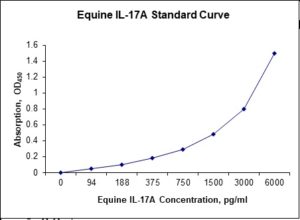Nori Equine IL-17A ELISA Kit-BALF
$461.00 – $832.00
This ELISA kit is for quantification of IL-17A in horse. This is a quick ELISA assay that reduces time to 50% compared to the conventional method, and the entire assay only takes 3 hours. This assay employs the quantitative sandwich enzyme immunoassay technique and uses biotin-streptavidin chemistry to improve the performance of the assays. An antibody specific for IL-17A has been pre-coated onto a microplate. Standards and samples are pipetted into the wells and any IL-17A present is bound by the immobilized antibody. After washing away any unbound substances, a detection antibody specific for IL-17A is added to the wells. Following wash to remove any unbound antibody reagent, a detection reagent is added. After intensive wash a substrate solution is added to the wells and color develops in proportion to the amount of IL-17A bound in the initial step. The color development is stopped, and the intensity of the color is measured.
Alternative names for IL-17A: Interleukin 17A, IL17A
This product is for Laboratory Research Use Only not for diagnostic and therapeutic purposes or any other purposes.
- Description
- How Elisa Works
- Product Citation (0)
- Reviews (0)
Description
Nori Equine IL-17A ELISA Kit-BALF Summary
Alternative names for IL-17A: Interleukin 17A, IL17A
Alternative name for equine: horse
| Assay Type | Solid Phase Sandwich ELISA |
| Format | 96-well Microplate or 96-Well Strip Microplate |
| Method of Detection | Colorimetric |
| Number of Targets Detected | 1 |
| Target Antigen Accession Number | A0A3Q2HZ94 |
| Assay Length | 3 hours |
| Quantitative/Semiquantitative | Quantitative |
| Sample Type | Plasma, Serum, Cell Culture, Urine, Cell/Tissue Lysates, Synovial Fluid, BAL, |
| Recommended Sample Dilution (Plasma/Serum) | No dilution for sample <ULOQ; sufficient dilution for samples >ULOQ |
| Sensitivity | 18 pg/mL |
| Detection Range | 94-6000 pg/mL |
| Specificity | Equine IL-17A |
| Cross-Reactivity | < 0.5% cross-reactivity observed with available related molecules, < 50% cross-species reactivity observed with species tested. |
| Interference | No significant interference observed with available related molecules |
| Storage/Stability | 4 ºC for up to 6 months |
| Usage | For Laboratory Research Use Only. Not for diagnostic or therapeutic use. |
| Additional Notes | The kit allows for use in multiple experiments. |
Standard Curve
Kit Components
1. Pre-coated 96-well Microplate
2. Biotinylated Detection Antibody
3. Streptavidin-HRP Conjugate
4. Lyophilized Standards
5. TMB One-Step Substrate
6. Stop Solution
7. 20 x PBS
8. Assay Buffer
Other Materials Required but not Provided:
1. Microplate Reader capable of measuring absorption at 450 nm
2. Log-log graph paper or computer and software for ELISA data analysis
3. Precision pipettes (1-1000 µl)
4. Multi-channel pipettes (300 µl)
5. Distilled or deionized water
Protocol Outline
1. Prepare all reagents, samples and standards as instructed in the datasheet.
2. Add 100 µl of Standard or samples to each well and incubate 1 h at RT.
3. Add 100 µl of Working Detection Antibody to each well and incubate 1 h at RT.
4. Add 100 µl of Working Streptavidin-HRP to each well and incubate 20 min at RT.
5. Add 100 µl of Substrate to each well and incubate 5-30 min at RT.
6. Add 50 µl of Stop Solution to each well and read at 450 nm immediately.
Background:
Interleukin 17 is a cytokine that acts as a potent mediator in delayed-type reactions by increasing chemokine production in various tissues to recruit monocytes and neutrophils to the site of inflammation. IL-17 is produced by T-helper cells and is induced by IL–23 which results in destructive tissue damage in delayed-type reactions (1). Interleukin 17 as a family functions as a proinflammatory cytokine that responds to the invasion of the immune system by extracellular pathogens and induces destruction of the pathogen’s cellular matrix. Interleukin 17 acts synergistically with tumor necrosis factor and interleukin-1 (2). To elicit its functions, IL-17 binds to a type I cell surface receptor called IL-17R of which there are at least three variants IL17RA, IL17RB, and IL17RC (3).
The IL-17 family is comprised of at least six proinflammatory cytokines that share a conserved cysteine-knot structure but diverge at the N-terminus. In addition to IL-17A, members of the IL-17 family include IL-17B, IL-17C, IL-17D, IL-17E (also called IL-25), and IL-17F. IL-17 family members are glycoproteins secreted as dimers that induce local cytokine production and recruit granulocytes to sites of inflammation. IL-17 is induced by IL-15 and IL-23, mainly in activated CD4+ T cells distinct from Th1 or Th2 cells. IL-17F is the most homologous to IL-17 but is induced only by IL-23 in activated monocytes. IL-17B binds the IL-17B receptor, but not the IL-17 receptor; it is most homologous with IL-17D, which is expressed by resting CD4+ T cells and CD19+ B cells. IL-17E is mainly produced by Th2 cells and recruits eosinophils to lung tissue. IL-17C has a very restricted expression pattern but has been detected in adult prostate and fetal kidney libraries.
References
- Janis, K, et al. (2007). Kuby immunology. San Francisco: W.H. Freeman. pp. 396.
- Miossec P, et al. (2009). N. Engl. J. Med. 361 (9): 888.
- Starnes T, et al. (2002). J. Immunol. 169 (2): 642.
Be the first to review “Nori Equine IL-17A ELISA Kit-BALF”
You must be logged in to post a review.




























Reviews
There are no reviews yet.